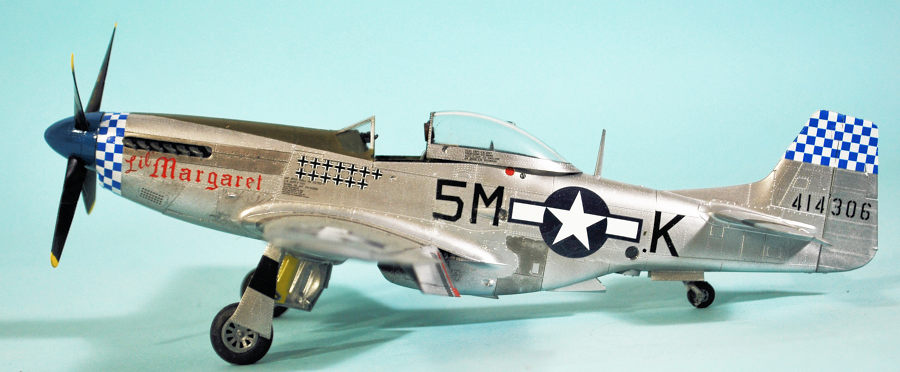
Eduard 1/48 P-51D/K (F-6D)
| KIT #: | R0020 |
| PRICE: | $98.00 |
| DECALS: | Fourteen options |
| REVIEWER: | Tom Cleaver |
| NOTES: | Aeromaster 48-716 “Southern European Mustange Pt. III |

| HISTORY |
Clyde East: the Tac-R Ace of Aces:
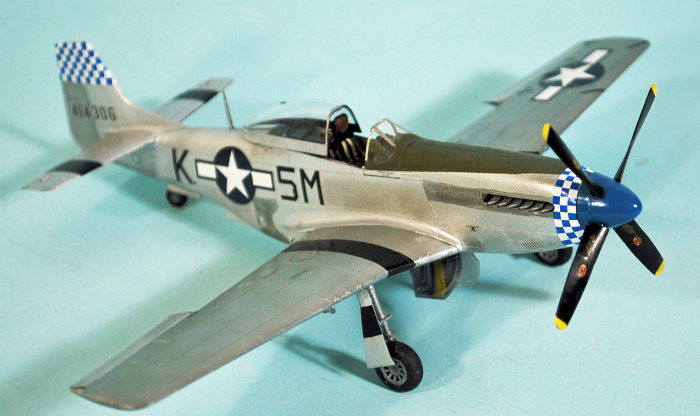 Born in
Pittsylvania County, Virginia on July 19, 1921, Clyde Bennett East was the fifth
of nine children. Raised on a rural family farm, he longed to experience
adventure in the military. At 19, failing to meet the entry requirements for the
US Army Air Corps, he traveled to Hamilton, Ontario, Canada to enlist in the
Royal Canadian Air Force. Soon after, East was admitted to pilot training and
completed his training in 1942. Arriving in the UK in late 1942, he was assigned
to 414 Squadron, which had just re-equipped with the Mustang I. During his tour
with the Canadians, he flew 26 missions in the tactical reconnaissance role.
Born in
Pittsylvania County, Virginia on July 19, 1921, Clyde Bennett East was the fifth
of nine children. Raised on a rural family farm, he longed to experience
adventure in the military. At 19, failing to meet the entry requirements for the
US Army Air Corps, he traveled to Hamilton, Ontario, Canada to enlist in the
Royal Canadian Air Force. Soon after, East was admitted to pilot training and
completed his training in 1942. Arriving in the UK in late 1942, he was assigned
to 414 Squadron, which had just re-equipped with the Mustang I. During his tour
with the Canadians, he flew 26 missions in the tactical reconnaissance role.
East transferred to the USAAF as a 1st Lieutenant. With his experience in tactical reconnaissance, he was assigned to the 15th Tactical Reconnaissance Squadron, 10th Tactical Reconnaissance Group, 9th Air Force, which was at the time flying the Spitfire P.R,XI. East flew 200 hours in the Spitfire before the squadron took delivery of the F-6C and shortly after the F-6D Mustang before D-Day. East named his F-6D “Li’l Margaret,” for his newly-born daughter.
East
achieved his first aerial victory on June 6, the day of the invasion, downing an
FW-190. The 15th TRS flew battlefield recon sorties in support of General
Patton’s dash across France. He didn’t score again until December 17, with the
outbreak of the Battle of the Bulge, shooting down a Bf-109 on December 17.
Following the Battle of the Bulge, as U.S. forces crossed the Rhine into
Germany, he found more opportunities for air combat, shooting down a Bf-109 on
March 15, 1945, two more on March 24, and two Ju-87s on March 27. During a
mission on April 4, he and his wingman came across a German airfield with
considerable activity, and he was credited with one Fw-190, ½ Ju-188, two 2
Ju-87s, one Si.204, ½ He-111 shot down. On April 13 he was credited with a final
Bf-109. It is alleged he shot down six other enemy aircraft by VE Day, but the
group c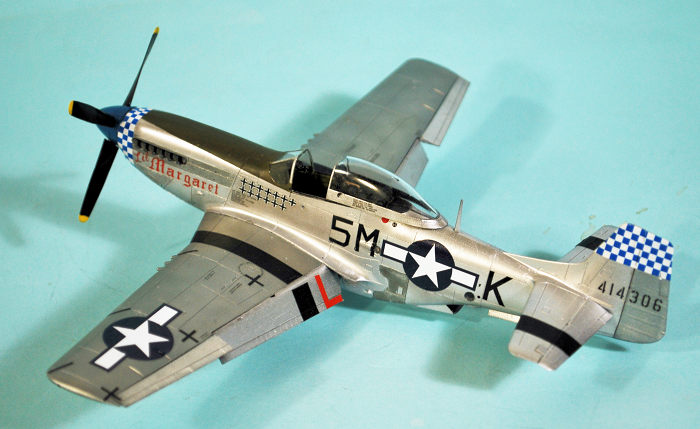 ommander
cut off awarding aerial victory credits to recon pilots on the grounds that
their job was to avoid air combat, not seek it out. By the end of the war, East
had 350 hours of combat time over 200 combat missions, with 13 aerial victories
(12 singles + 2 half credits).
ommander
cut off awarding aerial victory credits to recon pilots on the grounds that
their job was to avoid air combat, not seek it out. By the end of the war, East
had 350 hours of combat time over 200 combat missions, with 13 aerial victories
(12 singles + 2 half credits).
East remained in the Air Force after the war. In Korea, he flew 135 missions in RF-51s and a second tour in RF-80s. In 1951, he participated in the first combat missions to utilize air refueling, using KB-29 tankers that enabled the unarmed Shooting Stars to reach sensitive targets on the extreme northern borders of North Korea. He later commanded the 20th Tactical Reconnaissance Squadron, which flew 100 visual and photo missions over Cuba which verified the presence of Soviet missiles, of which East flew the first five crucial solo missions. In September 1964, he commanded Detachment Alpha, a force of four RF-101s that deployed to Southeast Asia following the Tonkin Gulf Incident, flying photo mapping operations over North and south Vietnam before the commencement of the U.S. air war, and retired as a Lt. Colonel in February, 1965.
East was awarded the Silver Star, Distinguished Flying Cross with 3 oak leaf clusters, and the Air Medal with 41 oak leaf clusters. In 1955, The Guinness Book of World Records listed him as having the highest number of repeat awards of combat medals.
| CONSTRUCTION |
I had originally planned to do “Li’l Margaret” with my second Eduard F-6D kit. Fortunately, I mentioned this to my friend and fellow Mustang Researcher Tom Ivie, who provided me photos that showed this would be wrong.
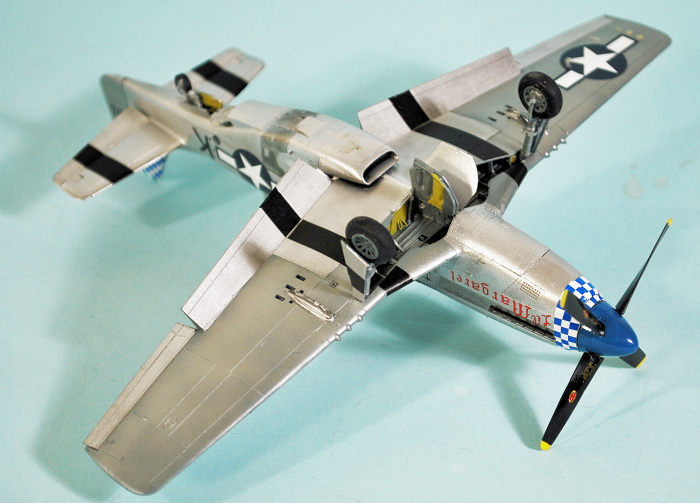 Due to the
fact that the only restored F-6D warbird carries the markings for East’s F-6D “Li’l
Margaret,” many aviation fans and modelers (including me) assume that the real “Li’l
Margaret” was also a standard F-6D. However, East’s airplane was one of three
F-6Ds specially modified by removal of the panoramic camera position ahead of
the horizontal stabilizer, which was replaced with a camera mounted in an
oblique position behind the pilot’s seat just ahead of the trailing edge of the
wing, similar to the Mustang Is he had flown with the RCAF; most likely, this
was done with removal of the fuselage fuel tank, since the tactical recon
Mustangs didn’t need the range of the airplane in the escort role.
Due to the
fact that the only restored F-6D warbird carries the markings for East’s F-6D “Li’l
Margaret,” many aviation fans and modelers (including me) assume that the real “Li’l
Margaret” was also a standard F-6D. However, East’s airplane was one of three
F-6Ds specially modified by removal of the panoramic camera position ahead of
the horizontal stabilizer, which was replaced with a camera mounted in an
oblique position behind the pilot’s seat just ahead of the trailing edge of the
wing, similar to the Mustang Is he had flown with the RCAF; most likely, this
was done with removal of the fuselage fuel tank, since the tactical recon
Mustangs didn’t need the range of the airplane in the escort role.
Thus, the kit to use is the standard P-51D. The necessary conversion is easy: open up the lower camera port just above the tail wheel, which is molded into the left fuselage half. Then drill out the port for the oblique camera. The fairing over that can easily be made by cutting a piece of sprue, shaping it, then gluing in position. You finish off by attaching the vertical camera port, which is on the sprue of all Eduard Mustang kits.
Following that simple set of modifications, the rest of the project merely involves building a standard Eduard P-51D. In addition to not attaching Part G-34 to the roof of the main gear welol and instead attaching it to the cockpit floor it has to mate to, I also positioned the assembled instrument panel/rudder pedals/gunsight assembly in the cockpit before gluing the fuselage halves together, rather than inserting it after that; this made sure it was in the proper position so the windshield would attach properly without being forced. These two modifications to the assembly sequence removed the “fiddliness” from the whole process.
| COLORS & MARKINGS |
I first painted the wings and rudder with Tamiya XF-16 Flat Aluminum, thinned 50-50 with clear gloss varnish. That was masked off, and the anti-glare panel was painted with olive drab and masked off. Then the model was given a primer coat of Tamiya X-18 Semi-Gloss Black, thinned 50-50 and misted on.
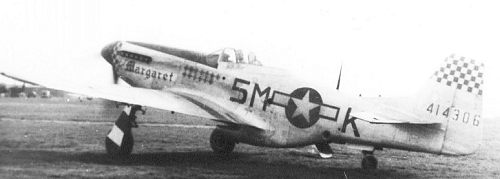 When
that was dry, I shot a coat of Vallejo “Aluminum” over the model. I followed
that when it had set up overnight by masking and painting various panels with
other shades of Vallejo metallics. The dark panels above and below the exhaust
were done with Duraluminum.
When
that was dry, I shot a coat of Vallejo “Aluminum” over the model. I followed
that when it had set up overnight by masking and painting various panels with
other shades of Vallejo metallics. The dark panels above and below the exhaust
were done with Duraluminum.
I used the Aeromaster “Southern European Mustangs Part III” decal sheet, 48-719, which has the markings for Li’l Margaret. Since Tom Ivie did the research for the sheet, the decal profile for this airplane does have the modified camera port shown, though Aeromaster made no mention of the need to make this modification in their instructions. I did the wing and tail ID stripes using decals from the Airfix P-51D kit. The decals went down with no problem under a coat of Solvaset.
I assembled and attached the main gear, then the prop, then unmasked the canopy and windshield and mounted the canopy in the open position.
| CONCLUSIONS |
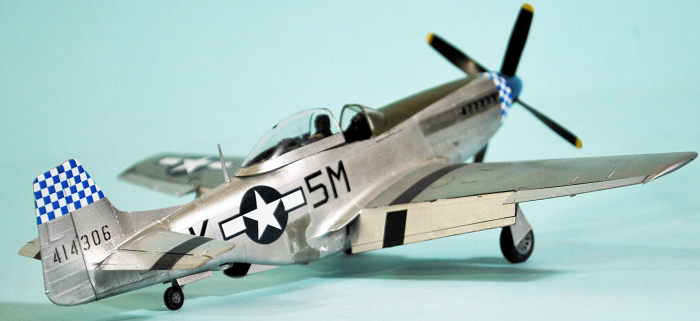 “Li’l
Margaret” is one of those “famous airplanes” about which people seem to not know
as much about it as they should. It’s another example of what “assume” does. The
modification is easy and the result is a one-of-a-kind model in your Mustang
collection.
“Li’l
Margaret” is one of those “famous airplanes” about which people seem to not know
as much about it as they should. It’s another example of what “assume” does. The
modification is easy and the result is a one-of-a-kind model in your Mustang
collection.
Yes, the Eduard P-51Ds continue to be the best kit of this airplane in 1/48 and I recommend them unhesitatingly. Follow my tricks to “de-fiddly” the process and you’re guaranteed a nice result.
18 February 2021
Copyright ModelingMadness.com. All rights reserved.
Review kit courtesy of Eduard.
If you would like your product reviewed fairly and fairly quickly, please contact the editor or see other details in the Note to Contributors.
Back to the Main Page Back to the Review Index Page Back to the Previews Index Page